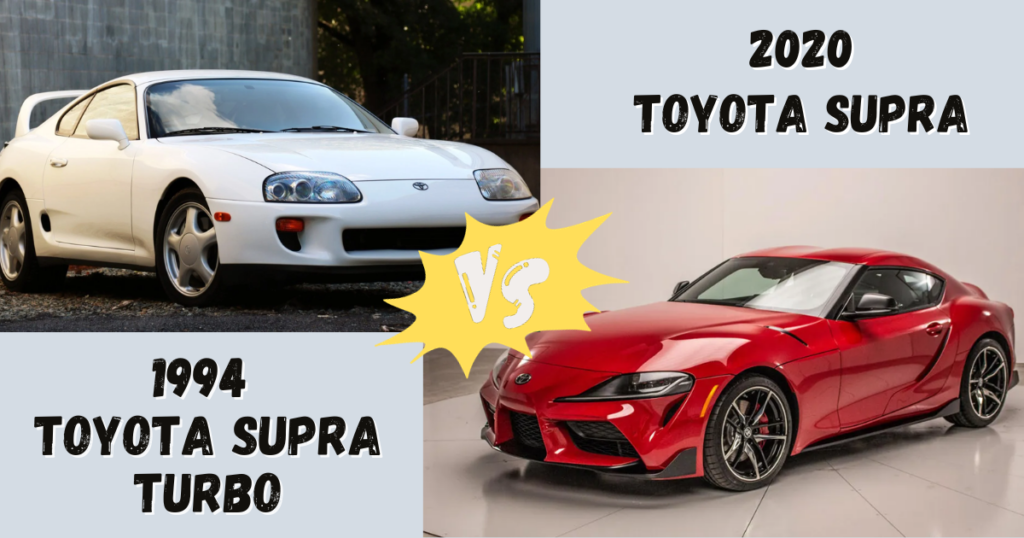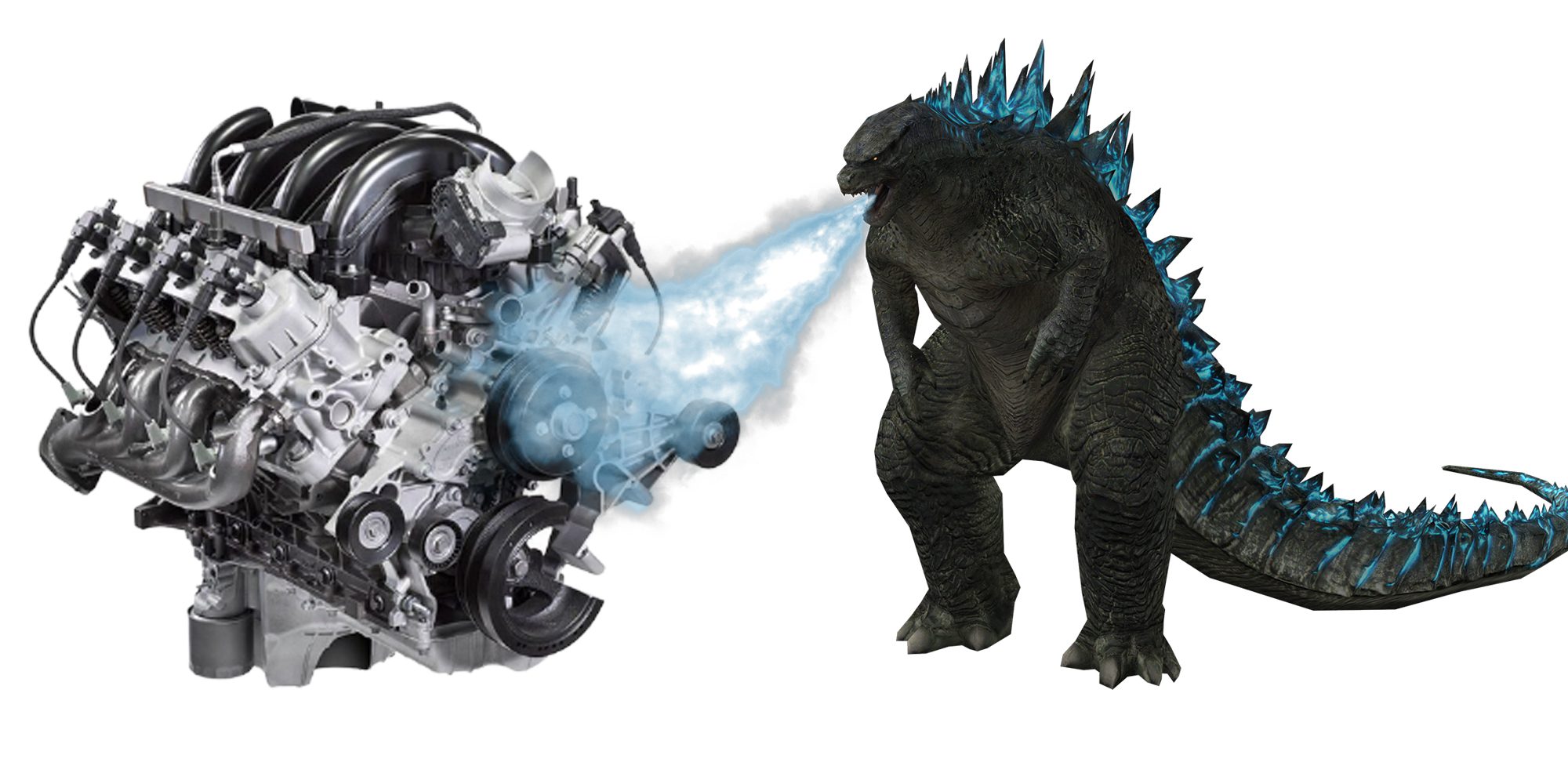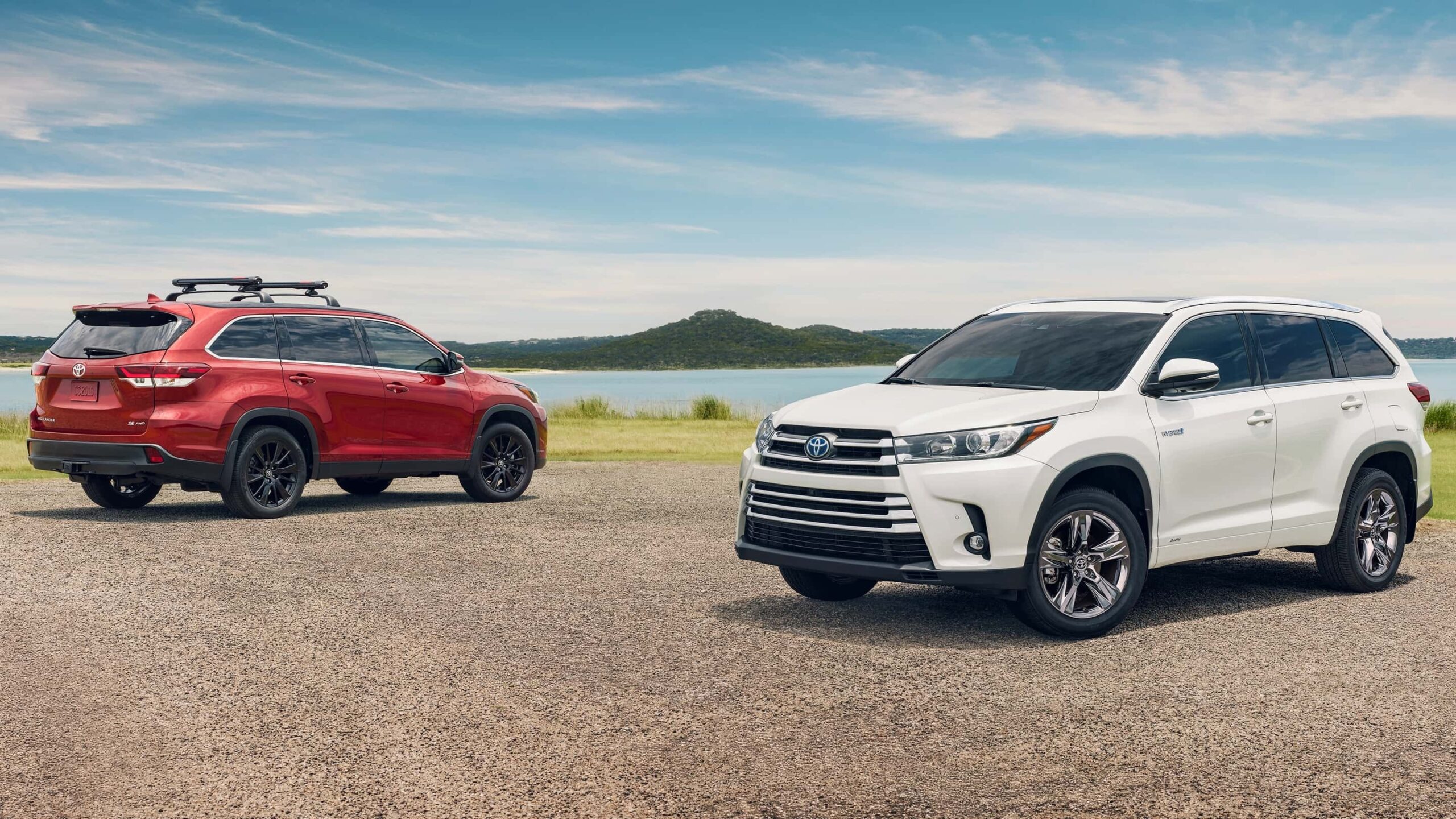
Among the world of car fans, there is a long-standing rivalry that comes into play when we examine two exceptional Toyota Supra versions side by side. This conflict spans decades, but the appeal remains as strong as the snarling motors of these incredible cars.
The 2020 Toyota Supra, a modern engineering marvel with cutting-edge speed and technology, is located on one side. On the other hand, there is the 1994 Toyota Supra Turbo, a beloved classic that will permanently be engraved in the records of automotive history.
A Quick Comparison
| 2020 Toyota Supra | VS | 1994 Toyota Supra Turbo |
| $49,990 | Starting MSRP | $36,900 |
| 24 / 31 / 26 | MPG | 17 / 23 |
| 2.0 L 4-cylinder, 3.0 L 6-cylinder | Engine | 3.0 L 6-cylinder |
| 335 hp | Horsepower | 320 hp |
| 365 lb-ft (494.87 Nm) | Torque | 315 lb-ft (427.08 Nm) |
| Rear Wheel Drive | Drivetrain | Rear Wheel Drive |
| 2 Passengers | Seating Capacity | 2 Passengers |
| eight-speed automatic | Transmission | 5-speed manual |
Past VS Present: Supra’s Epic Duel
When comparing the 2020 Toyota Supra to its 1994 predecessor, the automotive world witnesses a collision of eras. Exhibiting at the 2019 North American International Auto Show, the 2020 model is a joint creation of BMW and Toyota. It can go from 0 to 60 mph (96.56 kph) in just 4.1 seconds thanks to its 2.0-liter turbocharged engine and its 3.0-liter turbocharged counterpart.

Conversely, the 3.0-liter engine of the 1994 Toyota Supra—the final model before the 2020 revival—earned recognition in the American market thanks to its six-speed gearbox and 320 horsepower.
Unleashing the 2JZ: A Tale of Two Supra Engines
Despite its reputation for being quiet, the venerable Toyota 2JZ engine lives true to its smooth and refined nature. A lot of owners choose to increase the volume by installing aftermarket exhaust systems. By contrast, the new Supra is much louder during gear changes thanks to its enhanced six-cylinder engine, especially in Sport mode.

With the Mark IV Supra, turbo lag wasn’t an issue, and it isn’t now. The two turbos on the 2JZ engine operate in succession; the first begins to gain boost at about 2000 RPM and provides a strong push by 2500 RPM.
At 4000 RPM, the second turbo joins the group. When driven aggressively, the earlier Supra’s controls become more responsive and have a heavier clutch and shifter. Nevertheless, the sturdy structure of the current machine is different from the rigidity of its chassis.
2020 VS 1994 Toyota Supra Turbo: A Feature Face-Off
Although the 2020 and 1994 Supra models are hatchbacks, they differ significantly in a few important ways. The 1994 Supra had a two-plus-two seating configuration; the 2020 Supra is now a two-seater. The 2020 Supra is now 5.2 in (132.08 mm) shorter than the Mark IV, measuring 172.5 in (4381.5 mm) in length as a result of this modification. At 97.2 in (2468.88 mm), its wheelbase is 3.2 in (81.28 mm) shorter as well.
The 1994 Supra had a plastic fuel tank, hollow anti-roll bars, a single exhaust outlet, an aluminum hood, a roof, and bumper supports to save weight. To reduce weight, hollow fibers were even employed in the carpet. The current Supra weighs 3372 lb (1529.5 kg), which is more than 100 lb (45.35 kg) less than it did before these weight-saving techniques. With 51.5% of its weight on the front tires as opposed to the Mark IV’s 53.0%, it is likewise more balanced.
When it was brand-new in 1994, the Supra Turbo was highly recognized for consistently surpassing its Japanese competitors. It was lauded for its speed, comfort, and refinement; it could hit 60 mph (96.56 kph) in 4.6 seconds and reach 109 mph (175.4 kph) in 13.1 seconds for the quarter-mile. Later models, on the other hand, were slower, requiring 13.8 seconds to complete the quarter-mile and 5.2 seconds to reach 60 mph (96.56 kph). Impressive lateral acceleration and stopping power were shown by both variants.

The new Supra, however, performs better than the old model. It accelerates from 0 to 60 mph (96.56 kph) in just 3.7 seconds when equipped with launch control and BMW-spec tires. It completes the quarter-mile at 113 mph (181.85 kph) in 12.2 seconds. Shorter braking lengths and increased lateral acceleration are also achieved.
The two Supras also have different looks. The 1994 Supra’s headlamp lenses, grille design, and rear spoiler were all style influences taken from the Ferrari F40, yet the new Supra has a distinctive look that has been called unique.
Both versions have comparable instrumentation, with tachometers positioned in the center. The 2020 Supra’s interior, with its contemporary steering wheel, well-bolstered seats, and sophisticated technologies, is primarily BMW. The 1994 Supra’s cabin, with its low cowl and slim A-pillars, is more roomy and offers improved vision. Despite its size, it drives lighter and smaller.
Supra Through Time: A Price Comparison of Past and Present
Though they come from different eras and technical styles, the new Supra and its predecessor have similar qualities in terms of ride comfort, responsive handling, and a refined and musical engine. They share some characteristics, which may indicate that they have similar DNA.
Especially when accounting for inflation, the $49,990 base price of the contemporary Supra represents great value. By contrast, the basic price of the 1994 Supra is $36,900.
It’s important to note that fourth-generation Supras have become much more expensive recently, particularly the well-preserved Turbo variants. At auction, several have brought in more than $175,000, which is indicative of their collector’s value.
Supra Safety Evolution
These two legendary Supra generations provide a distinctive viewpoint on the development of safety in the automobile sector.
The 2020 Supra comes with an extensive list of active safety systems, including automated emergency braking, adaptive cruise control, blind-spot monitoring, rear cross-traffic alert, and automatic highlights.

With the active help of these technologies, drivers can prevent possible crashes and risks but the 1994 Toyota Supra Turbo in the automotive industry had very few active safety features in 1994, and the 1994 Supra is devoid of all of the cutting-edge driver assistance technologies featured in contemporary cars. It depends more on the abilities and focus of the driver.
Integrative Safety Elements
The 2020 Supra is equipped with several passive safety measures, including a strengthened body structure that efficiently absorbs and disperses collision forces. In the event of an accident, the front and side impact airbags will protect the occupants.
While the 1994 Toyota Supra Turbo is equipped with driver and passenger airbags, the 1994 Supra boasts passive safety features that were common in its age. However, these airbags were not as sophisticated as the complex airbag systems found in modern cars.
Control of Traction and Stability
2020 Toyota Supra Turbo in especially bad driving circumstances, the 2020 Supra’s cutting-edge traction and stability control systems improve stability and guard against sliding or losing control but the 1994 Toyota Supra Turbo is equipped with rudimentary traction and stability control systems.
Though they are not as sophisticated as the cutting-edge technology seen in the 2020 Supra, they nonetheless provide some aid.
Brake Mechanisms
The 2020 Toyota Supra Turbo has an advanced braking system with electronic brake-force distribution (EBD) and anti-lock brakes (ABS). These innovations offer effective braking under a range of driving circumstances, whereas the 1994 Toyota Supra Turbo is outfitted with a conventional braking system that incorporates anti-lock brakes (ABS).
While ABS was a major safety advancement at the time, it is not as sophisticated as contemporary brake systems.
FAQS
Which Supra model—the 1994 model or the 2020 model—has a longer wheelbase?
The 2020 Toyota Supra has a somewhat shorter wheelbase of 128.7 in (3268.9 mm) than the 1994 Toyota Supra, which had a longer wheelbase of 131.4 in (3337.5 mm).
How much is the 2020 Toyota Supra cheaper than the 1994 Supra?
The 2020 Toyota Supra is not less expensive than the Supra from 1994. The 1994 Supra was more reasonably priced when it was new, but the 2020 Supra has a higher beginning price.
Is the 1994 model or the 2020 edition of the Supra more well-known?
The 1994 Toyota Supra attracted a devoted fan base and became well-known for its exceptional performance and stylish appearance for its time. Despite being cutting-edge and contemporary, the 2020 Supra might not be as well-known as the legendary 1994 Supra.
Is there a luxury trim level available for the 2020 Toyota Supra?
The Toyota Supra Premium is an upper-class trim offered by the 2020 Toyota Supra. Compared to the 1994 Supra, this version is a more sophisticated option because of the features and design improvements that give the car a hint of elegance.
Is the 1994 Supra or the 2020 Supra more fuel-efficient?
The 2020 Toyota Supra’s contemporary engine management systems and design contribute to its higher fuel efficiency. It is a more fuel-efficient option for daily driving than the 1994 Supra since it receives a higher miles per gallon (MPG) rating.
Conclusion
Although the 2020 Supra starts at a greater price than the 1994 Supra, it comes with more power and contemporary technologies. Despite being less expensive, the 1994 Supra can’t compete with the 2020 model’s features and acceleration.
If you value nostalgia and traditional design, the 1994 Supra may be the best option. But the 2020 Supra is the obvious choice for individuals looking for cutting-edge safety, speed, and modern conveniences.




